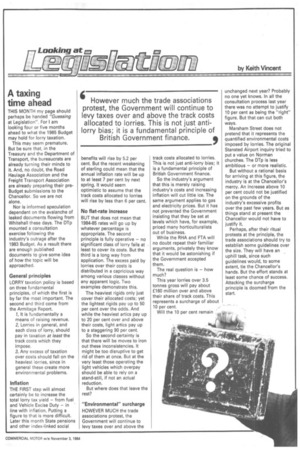A taxing time ahead
Page 57

If you've noticed an error in this article please click here to report it so we can fix it.
THIS MONTH my page should perhaps be handed "Guessing at Legislation". For I am looking four or five months ahead to what the 1985 Budget may hold for lorry taxation.
This may seem premature. But be sure that, in the Treasury and the Department of Transport, the bureaucrats are already turning their minds to it. And, no doubt, the Road Haulage Association and the Freight Transport Association are already preparing their preBudget submissions to the Chancellor. So we are not alone.
Nor is informed speculation dependent on the avalanche of leaked documents flowing from Whitehall these days. The DTp mounted a consultation exercise following the industry's outrage after the 1983 Budget. As a result there are enough published documents to give some idea of how the topic will be approached.
General principles LORRY taxation policy is based on three fundamental principles, of which the first is by far the most important. The second and third come from the Armitage Report.
1, It is fundamentally a means of raising revenue.
2, Lorries in general, and each class of lorry, should pay in taxation at least the track costs which they impose.
3, Any excess of taxation over costs should fall on the heaviest lorries, since in general these create more environmental problems.
Inflation THE FIRST step will almost certainly be to increase the total lorry tax yield — from fuel and Vehicle Excise Duty — in ' line with inflation. Putting a figure to that is more difficult. Later this month State pensions and other index-linked social benefits will rise by 5.2 per cent. But the recent weakening of sterling could mean that the annual inflation rate will be up to at least 7 per cent by next spring. It would seem optimistic to assume that the track costs allocated to lorries will rise by less than 6 per cent.
No flat-rate increase
BUT that does not mean that 1984-85 rates will go up by whatever percentage is appropriate. The second principle is fully operative — no significant class of lorry fails at least to cover its costs. But the third is a long way from application. The excess paid by lorries over their costs is distributed in a capricious way among various classes without any apparent logic. Two examples demonstrate this.
The heaviest rigids only just cover their allocated costs; yet the lightest rigids pay up to 50 per cent over the odds. And while the heaviest artics pay up to 20 per cent over and above their costs, light artics pay up to a staggering 90 per cent.
So the second certainty is that there will be moves to iron out these inconsistencies. It might be too disruptive to get rid of them at once. But at the very least those operating the light vehicles which overpay should be able to rely on a stand-still, if not an actual reduction.
But where does that leave the rest? track costs allocated to lorries. This is not just anti-lorry bias; it is a fundamental principle of British Government finance.
So the industry's argument that this is merely raising industry's costs and increasing inflation will cut little ice. The same argument applies to gas and electricity prices. But it has not prevented the Government insisting that they be set at levels which have, for example, priced many horticulturalists out of business.
While the RHA and FTA will no doubt repeat their familiar arguments, privately they know that it would be astonishing if the Government accepted them.
The real question is — how much?
This year lorries over 3.5 tonnes gross will pay about £160 million over and above their share of track costs. This represents a surcharge of about 10 per cent.
Will the 10 per cent remain unchanged next year? Probably no one yet knows. In all the consultation process last year there was no attempt to justify 10 per cent as being the "right" figure. But that can cut both ways.
Marsham Street does not pretend that it represents the quantified environmental costs imposed by lorries. The original Stansted Airport inquiry tried to put a value on Norman churches. The DTp is less ambitious — or more realistic.
But without a rational basis for arriving at this figure, the industry is at the Chancellor's mercy. An increase above 10 per cent could not be justified on the grounds of the industry's excessive profits over the past few years. But as things stand at present the Chancellor would not have to justify it.
Perhaps, after their ritual protests at the principle, the trade associations should try to establish some guidelines over the size. They will have an uphill task, since such guidelines would, to some extent, tie the Chancellor's hands. But the effort stands at least some chance of success. Attacking the surcharge principle is doomed from the start.








































































































